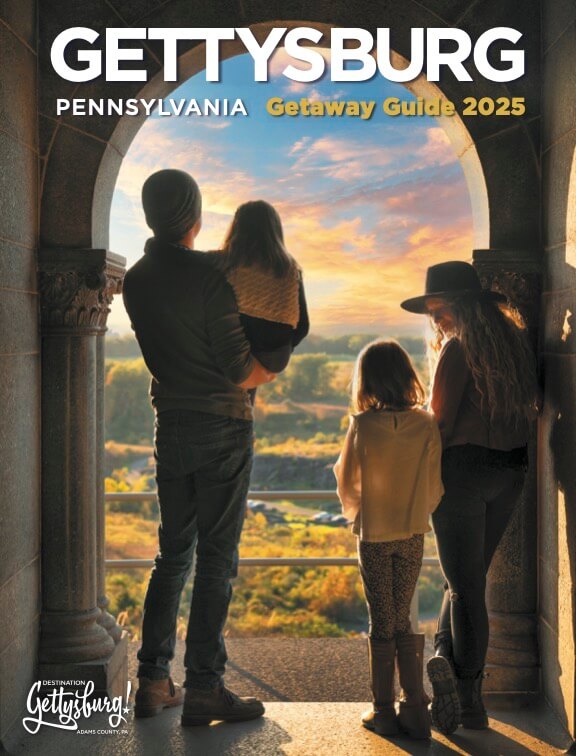Get the 2025 Gettysburg Getaway Guide
Check out our Getaway Guide online or have us send you one. Have an immediate question? Call us at 1.800.337.5015
Get the GuideGeneral Dwight D. Eisenhower was a resident of Gettysburg not only during his later years, but also early in his military career as the commander of Camp Colt, a tank training camp on the fields of Pickett’s Charge, during World War I. During both of those experiences, Eisenhower could be found throughout the town and the battlefields in service of his country as well as his family. The homes where he lived, buildings where he worked and battlefields he lead through can all be seen today across the town. Lace up your boots and visit these five places where you can walk in footsteps of General Eisenhower – the title he preferred over President.
Located along the eastern side of Emmitsburg Road, just to the south of the town of Gettysburg, stands a lone pine tree. This tree and the small plaque standing in front of it, are all that is left to commemorate Camp Colt. From March 1918 to March 1919, this World War I tank training camp was located on the fields of Pickett’s Charge. Leading this new camp was a young Captain Dwight D. Eisenhower, eager to prove himself and get overseas where the action was. Through a myriad of challenges including having no tanks to train the men with, a late spring snow-storm burying the men’s tents and a strain of Spanish Flu that killed more than 150 that fall, Captain Eisenhower persevered and trained more than 10,000 men at Camp Colt. Today you can visit the tree which was planted in 1954 by veterans of the Camp and stands near the location of Captain Eisenhower’s office.
During his time as the Commander of Camp Colt, Captain Eisenhower lived in no fewer than three homes with his young family. He, his wife Mamie, and their infant son Icky moved into the North Washington Street Alpha Tau Omega Fraternity house on the Gettysburg College campus in late spring when the college let out for the summer, and remained there until the students returned that fall. It was a much-needed improvement over their first Gettysburg address which lacked a proper kitchen, forcing Mamie to wash dishes in the family bathtub. Today, the Eisenhower Academy occupies the building.
Previously famous as the church President Lincoln visited after delivering the Gettysburg Address, the Gettysburg Presbyterian Church once again took to the headlines when two new residents permanently moved to town in the early 1960s. Throughout their retirement years, Dwight and Mamie Eisenhower were members of the Gettysburg Presbyterian Church at the corner of Baltimore and High Streets. The Eisenhower’s, who often arrived late and departed early so as to minimize the chaos of their secret service motorcade, not only worshiped at the church but were also active members of the congregation. President Eisenhower donated several of his personal effects to the church which remain there today, including the country’s first 50-star flag. Created during Eisenhower’s presidency after Hawaii joined the Union during his second term, the flag and the pew in which the Eisenhower’s sat, are still on display today.
In his retirement, General Eisenhower found it necessary to secure an office outside of his home where he could frequently visit and work on his memoirs. Gettysburg College offered him such a location in their present-day Admissions building. From this office at 300 Carlisle Street, the General completed four volumes of memoirs, met with world leaders, acted as a political consultant and met with faculty and students of the college regularly. On the 80th anniversary of his birth, a statue of General Eisenhower was dedicated outside of this office, with Mamie present, to memorialize the Eisenhower’s contributions to and establishment within the Gettysburg community.
In 1950, after more than 30 years living a life of service to their country and moving from home to home across the world, Ike and Mamie finally settled on a piece of land in Gettysburg where they could enjoy their retirement together. Little did they know that there was one last challenge that lay in front of them; two terms and eight years serving as President and First Lady of the United States. During this time, they would spend weekends working to renovate their 200-year-old farmhouse and update it with all the most modern conveniences, including air conditioning. It was here they would come when Ike needed to recover from his 1955 heart attack, and when Eisenhower needed to speak in a comfortable setting with Cold War adversary and Soviet leader, Nikita Khrushchev. Here too, is where the Eisenhower’s drove themselves to the only home they would ever own, after watching President Kennedy be sworn into office one cold snowy day in January 1961. They lived out the remainder of their life together here on the farm, surrounded by friends, family and a few close Secret Service agents. Today, you can visit Eisenhower National Historic Site, which is run by the National Park Service, and learn about Ike and Mamie at the home they cherished together.
Here’s an extra opportunity – every year, Eisenhower National Historic Site hosts World War II Weekend. This event gives visitors a chance to visit the site and to dive deeper into the history of World War II. The event is filled with reenactors, period vehicles and equipment, veterans of the war, an interactive children’s program, speakers and more. Be sure to keep your eye out for details on this annual event!

Check out our Getaway Guide online or have us send you one. Have an immediate question? Call us at 1.800.337.5015
Get the GuideDon’t miss a thing that’s going on in Gettysburg; sign up to receive our fun and informative travel planning newsletter.
Let's Go